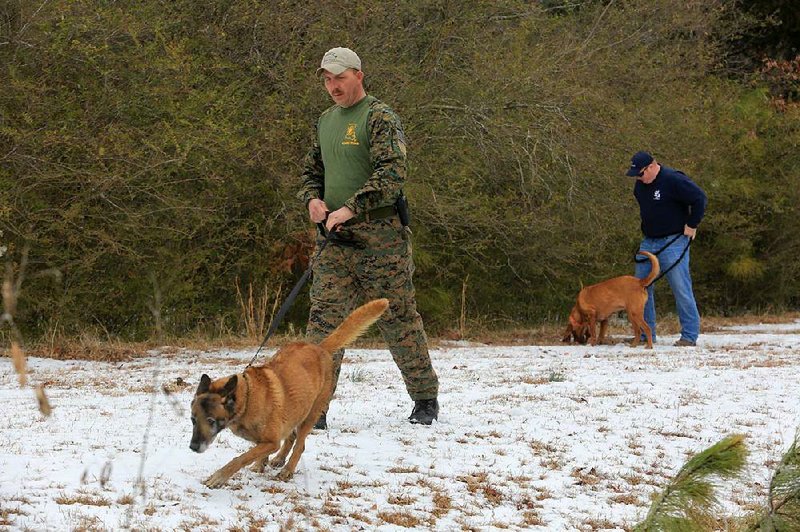An icon of prisons in the South, bloodhounds appear often in films and music in which inmates - or fugitives - play a role.
There’s the lanky dog with sagging jowls that accompanies the sheriff in O Brother, Where Art Thou? And there’s Ol’ Red, the hound featured in one of country singer Blake Shelton’s songs. The lyrics tell the tale of a prison hound who’s a “four-legged tracking machine.”
And the warden sang, “Come on somebody, why don’t you run? Ol’ Red’s itchin’ to have a little fun. Get my lantern, get my gun. Red’ll have you treed before the mornin’ comes.”
Arkansas has had its share of Reds, which is one of the reasons it’s one of only two states to host an annual dog-tracking competition. The other is Florida.
This week, 28 teams from several states are at Camp Robinson in North Little Rock to run their dogs in the 14th annual Southern States Manhunt Field Trials.
The dogs - bloodhounds, black and tan coon hounds, and beagles - got a helping hand from Mother Nature this year. Contrary to popular belief, moisture enhances a human’s scent. Trying to flee a prison? Don’t bother with crossing a river. Tracking dogs will pick up an even stronger scent on the other side.
So recent ice accumulations from Sunday and Monday’s winter weather proved useful to the canine competitors.
“Missouri dogs are used to this stuff,” boasted a handler from that state’s prison system.
But Zoe, Zelda and Ziva - 5-month-old black and tans from the Arkansas Department of Correction’s Central Office Canine Unit - weren’t fazed at all by the packed ice and snow. Zoe and Ziva found their quarry in just 35 minutes Wednesday - not bad for their first competition, said Sgt. Derek Wilson, one of the handlers.
“If they do well tonight, they could get a plaque before they’re 6 months old,” added Lt. Troy Moore, another of the trio’s handlers.
The pups begin training when they’re 5 to 6 weeks old. Because their vision remains blurry at that time, the hounds learn from the start to trust their noses.
Tracking dogs have a storied past in Arkansas. They’re kept in kennels on prison grounds and trained by inmates. Known as “dog-boys,” the inmates do their best to elude dogs during practice runs.
Over the years, prisoners have tried tricking the hounds by tying plywood to their shoes or running through fuel, to no avail. The dog-boys know better than anyone how tough it is to evade a pack of bloodhounds. That’s why they’re the least likely to attempt a prison break.
“I’ve never had a dog-boy escape,” Lt. Harry Rhodes, head of Cummins Unit kennel, said during an interview in the 1980s. “It’s hard to believe they’d think they could beat the dogs. About the only way a man is going to beat those animals is in a vehicle.”
On one occasion, prison bloodhounds successfully tracked an escapee riding a bicycle on the streets of Pine Bluff. They tracked another fugitive from the Cummins Unit to a cotton field that was 5 miles north of the prison.
In January 1979, 18 inmates seized control of the Cummins Unit. In the ensuing chaos, seven of them made it off prison property. Four were found by lawmen. The other three were hunted down by the prison’s bloodhounds. Just six months earlier, the dogs treed a murderer who escaped to avoid execution.
Hounds often do the tracking in free-roaming packs, in which case searchers follow on horseback to keep up with the dogs. Or the animals may be leashed by handlers. Most dogs work for five years before they’re eased into a life of retirement. Except, that is, for Dottie, the grande dame of the Arkansas prison hounds.
Born on Sept. 3, 1981, Dottie was featured in the Arkansas Democrat-Gazette in 2000, when she turned 19.
Dottie was a bit of a miracle in the veterinary world, veterinarian Lance Grissom said at the time. A mix of bloodhound, redbone coonhound, and black and tan, Dottie spent years hunting down fugitives, lost children and Alzheimer’s patients who had wandered away.
When she reached retirement age, Dottie became prolific in the breeding department. She gave birth to dozens upon dozens of puppies, many of which went on to become proficient trackers like their mother. Dottie also helped keep a group of irascible beagle puppies in line.
As for this week’s trio of Arkansas pups competing in the manhunt trials, they’ve got their mother with them to ensure that they behave themselves.
That’s a good thing. Because once freed from their kennel, the ever-playful Zelda, Zoe and Ziva have a tendency to become fugitives themselves.
Arkansas, Pages 9 on 03/06/2014
